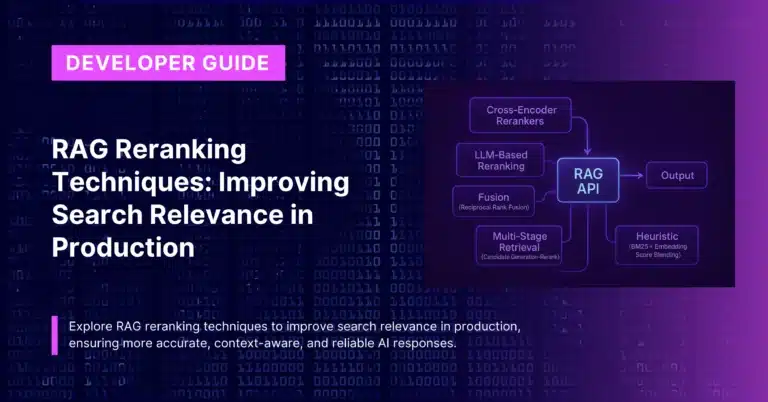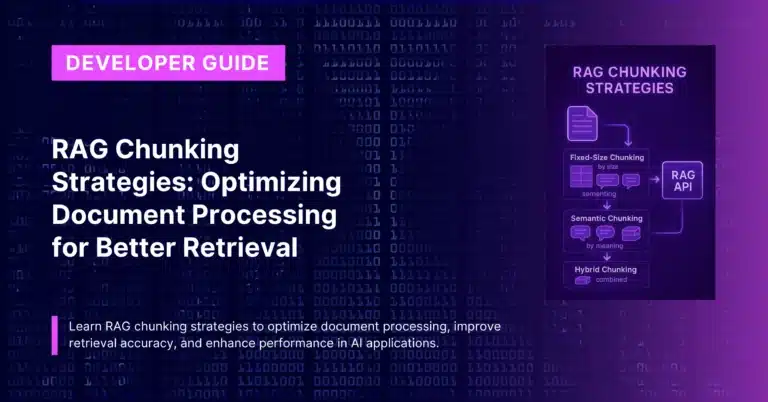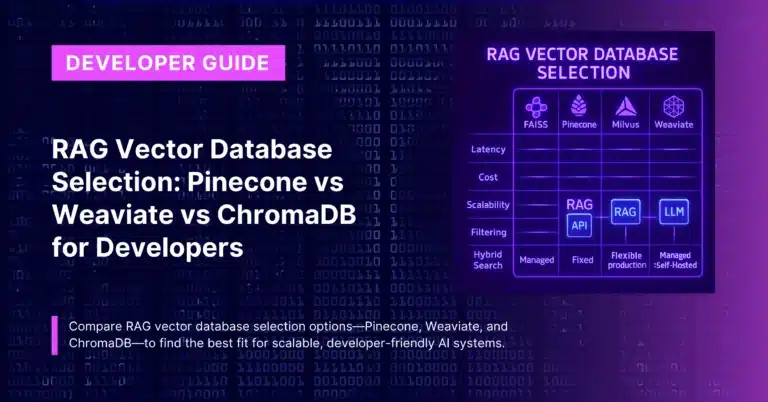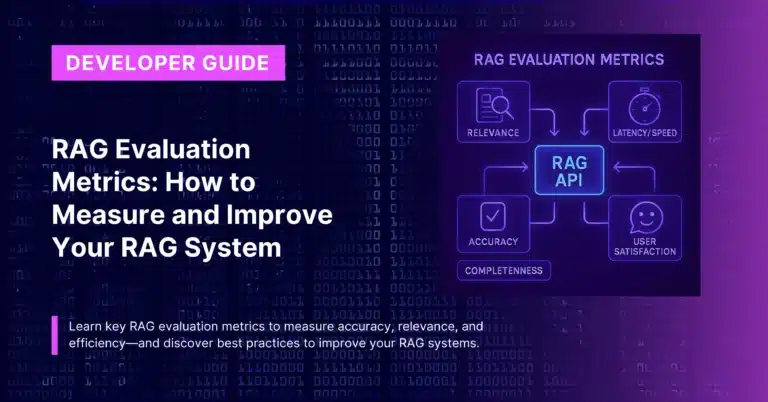
TL;DR
- RAG vs Fine-Tuning: RAG excels for dynamic, data-rich applications needing real-time information updates, while fine-tuning works best for specialized, static use cases requiring deep domain expertise.
- Most developers should start with RAG for faster implementation and lower costs, then consider fine-tuning only for highly specific tasks where retrieval-based approaches fall short.
When building AI applications with Large Language Models (LLMs), developers face a critical decision: how to adapt these powerful but general-purpose models for specific business needs.
Two dominant approaches have emerged—Retrieval-Augmented Generation (RAG) and fine-tuning—each with distinct advantages, limitations, and optimal use cases.
The choice between these methods isn’t just technical; it fundamentally shapes your application’s architecture, maintenance requirements, and long-term scalability.
Understanding when to use each approach can mean the difference between shipping a successful AI product and struggling with outdated information, high computational costs, or poor user experiences.
Understanding the Fundamental Differences
What is RAG?
Retrieval-Augmented Generation combines the broad knowledge of pre-trained LLMs with real-time access to external data sources. When a user asks a question, RAG systems:
- Retrieve relevant information from vector databases, knowledge bases, or APIs
- Augment the user’s query with this contextual information
- Generate responses using both the LLM’s training knowledge and retrieved data
This approach keeps the original model intact while providing access to fresh, domain-specific information at query time.
What is Fine-Tuning?
Fine-tuning involves retraining a pre-trained model on a smaller, domain-specific dataset. This process:
- Adjusts the model’s parameters based on your specific data
- Specializes the model for particular tasks or domains
- Embeds new knowledge directly into the model’s weights
The result is a customized model that “knows” your specific domain without needing external data sources.
Key Factors for Decision Making
Data Freshness Requirements
Choose RAG when:
- Information changes frequently (news, stock prices, product catalogs)
- Real-time updates are essential
- You need access to live data sources
Choose Fine-Tuning when:
- Domain knowledge is relatively stable
- Historical patterns matter more than current events
- Core business logic rarely changes
Real-world example: A customer support bot for a SaaS platform benefits from RAG because it can access the latest feature documentation, recent bug fixes, and current pricing. A legal document analyzer might use fine-tuning since legal principles evolve slowly and require deep understanding of precedents.
Implementation Complexity and Timeline
RAG Implementation Requirements:
- Vector database setup (Pinecone, Weaviate, ChromaDB)
- Embedding model integration
- Document processing and chunking strategies
- Retrieval pipeline optimization
Typical implementation time: 2-4 weeks for production-ready systems
Fine-Tuning Requirements:
- High-quality, labeled training data (often 1,000+ examples)
- Significant computational resources (GPUs)
- Model training expertise and validation processes
- Retraining pipelines for updates
Typical implementation time: 6-12 weeks including data preparation
Cost Considerations
RAG Operational Costs:
- Vector database hosting: $50-500/month depending on data volume
- Embedding API calls: $0.0001-0.001 per query
- Storage costs for document processing
- Lower upfront development costs
Fine-Tuning Costs:
- Initial training: $500-5,000+ depending on model size
- Inference costs: 2-6x higher than base models
- Retraining costs for updates
- Higher development time investment
For most applications under 100,000 monthly queries, RAG proves more cost-effective.
Accuracy and Performance Trade-offs
RAG Accuracy Factors:
- Heavily dependent on retrieval quality
- Can achieve 85-95% accuracy with well-tuned retrieval
- Provides source attribution and explainability
- May suffer from context length limitations
Fine-Tuning Accuracy:
- Often achieves higher accuracy for specific tasks (90-98%)
- Better understanding of domain terminology
- Consistent response formatting
- Risk of catastrophic forgetting of general knowledge
Practical Implementation Guidance
When RAG is the Right Choice
Ideal Use Cases:
- Customer support systems with evolving knowledge bases
- Research assistants needing current publications
- E-commerce product recommendations
- Financial analysis requiring real-time data
Technical Prerequisites:
- Familiarity with vector databases and embedding models
- Understanding of document chunking strategies
- API integration capabilities
- Basic knowledge of information retrieval concepts
Getting Started with RAG: For developers looking to implement RAG systems, the CustomGPT Developer Starter Kit provides a complete open-source foundation with voice features, multiple deployment options, and comprehensive documentation.
The kit leverages CustomGPT’s RAG API for enterprise-grade retrieval without the complexity of managing your own vector infrastructure.
When Fine-Tuning Makes Sense
Ideal Use Cases:
- Sentiment analysis for specific industries
- Code generation for proprietary programming languages
- Medical diagnosis support systems
- Legal document classification
Technical Prerequisites:
- Machine learning expertise for training and validation
- Access to high-quality, domain-specific datasets
- Computational resources (GPU clusters or cloud ML services)
- Understanding of model evaluation metrics
Fine-Tuning Best Practices:
- Start with smaller models (7B-13B parameters) to validate approach
- Ensure diverse, high-quality training data
- Implement proper validation to prevent overfitting
- Plan for regular retraining schedules
The Hybrid Approach: Combining RAG and Fine-Tuning
Recent research, including the RAFT (Retrieval-Augmented Fine-Tuning) paper from UC Berkeley, shows promising results from combining both approaches. This hybrid method:
- Fine-tunes models on domain-specific reasoning patterns
- Uses RAG for accessing current information
- Leverages both specialized knowledge and real-time data
Implementation Strategy:
- Fine-tune on domain-specific conversation patterns and terminology
- Use RAG for factual information retrieval
- Apply the fine-tuned model to generate responses using retrieved context
Making the Decision: A Practical Framework
Start with RAG if:
- ✅ Your data changes more than monthly
- ✅ You need source attribution and explainability
- ✅ You want faster time-to-market (weeks vs months)
- ✅ Your team has web development skills but limited ML expertise
- ✅ Budget constraints favor operational costs over upfront investment
Consider Fine-Tuning if:
- ✅ Domain knowledge is stable and well-defined
- ✅ You need consistent response formatting and tone
- ✅ Your use case requires deep understanding of specialized terminology
- ✅ You have high-quality training data and ML expertise
- ✅ Inference speed is critical (fine-tuned models are typically faster)
Hybrid Approach if:
- ✅ You have complex domain-specific reasoning requirements
- ✅ Both current information and specialized knowledge are essential
- ✅ You have resources for advanced implementation
- ✅ Maximum accuracy justifies increased complexity
Implementation Resources and Next Steps
For developers ready to implement either approach, consider these resources:
RAG Implementation:
- CustomGPT API Documentation – OpenAI-compatible RAG API
- Open Source RAG Examples – Social media bots and integrations
- Developer Starter Kit – Complete UI framework with voice features
Fine-Tuning Resources:
- Hugging Face Transformers library for model training
- OpenAI’s fine-tuning API for GPT models
- AWS SageMaker or Google Vertex AI for managed training
Getting API Access: Both approaches benefit from robust API infrastructure. You can create your CustomGPT API key at https://app.customgpt.ai to experiment with production-ready RAG systems without managing your own vector databases.
Frequently Asked Questions
Can I switch from RAG to fine-tuning later?
Yes, but it requires significant architectural changes. RAG systems provide external context at query time, while fine-tuned models embed knowledge in their parameters. Plan your initial approach carefully, as switching approaches often means rebuilding core system components.
Which approach handles edge cases better?
Fine-tuned models typically handle domain-specific edge cases better due to specialized training. However, RAG systems can access external resources to handle unexpected queries by retrieving relevant information, making them more adaptable to novel situations.
How do I measure success for each approach?
For RAG systems, focus on retrieval accuracy, source attribution quality, and response relevance. For fine-tuned models, measure task-specific accuracy, consistency, and retention of general capabilities. Both should be evaluated on response time and user satisfaction.
What about data privacy and security?
Fine-tuned models embed training data in model parameters, making data extraction difficult but not impossible. RAG systems keep source data in controlled databases but pass information through external APIs. Both approaches require careful security planning, with RAG offering more granular access control.
How often should I update each approach?
RAG systems can be updated by adding new documents to the knowledge base—potentially in real-time. Fine-tuned models require complete retraining cycles, typically every 3-6 months depending on how quickly your domain evolves.
The choice between RAG and fine-tuning ultimately depends on your specific requirements for data freshness, development timeline, available expertise, and budget constraints. Start with a clear understanding of your use case requirements, prototype both approaches if possible, and remember that the best solution might involve combining elements of both methods as your application matures.
For more RAG API related information:
- CustomGPT.ai’s open-source UI starter kit (custom chat screens, embeddable chat window and floating chatbot on website) with 9 social AI integration bots and its related setup tutorials.
- Find our API sample usage code snippets here.
- Our RAG API’s Postman hosted collection – test the APIs on postman with just 1 click.
- Our Developer API documentation.
- API explainer videos on YouTube and a dev focused playlist.
- Join our bi-weekly developer office hours and our past recordings of the Dev Office Hours.
P.s – Our API endpoints are OpenAI compatible, just replace the API key and endpoint and any OpenAI compatible project works with your RAG data. Find more here.
Wanna try to do something with our Hosted MCPs? Check out the docs for the same.
Priyansh is Developer Relations Advocate who loves technology, writer about them, creates deeply researched content about them.





